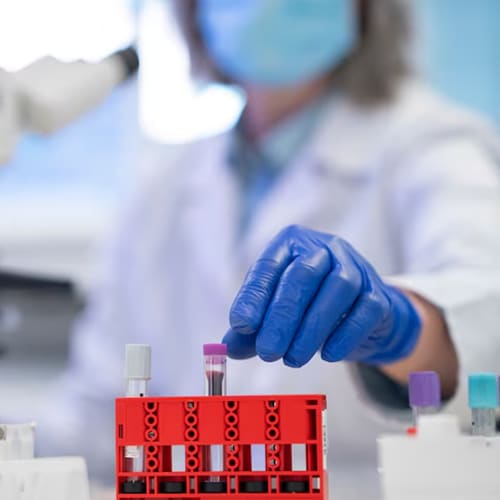Part 2 Interview with Jonas Hannestad, MD, PhD – Chief Medical Officer
In Part 2 of our discussion with Gain’s Chief Medical Officer Jonas Hannestad, MD, PhD, we get a more in-depth look at his experience and research with neurodegenerative disease drug development. Dr. Hannestad provides a granular look into his experience in both academia and industry. This leads us to his recent participation in the “Advances in Therapeutics Development for Parkinson’s Disease” workshop organized by the National Institute of Neurological Disorders and Stroke (NINDS), which included discussions about the intersection of academic research and industry implementation.
It’s rare to have a consensus of any kind when it comes to merging biomedical research with biopharma’s development of new medicine, but Dr. Hannestad feels the future is promising. While academia and industry have historically been disjointed, Dr. Hannestad says there has been a growing trend of collaboration over the past 15-20 years that has fostered progression in the world of biotechnology. It’s this merging of the minds, as well as collaboration with caregivers and patients themselves, that is paving the way toward true progress.
_________________________________________________________________________
Let’s talk about your experience in the CNS imaging domain. You’ve done extensive academic research focused on PET (positron emission tomography) imaging of neuroinflammation and neurotransmitter systems in psychiatric disorders, and on experimental medicine studies on the CNS effects induced by systemic LPS administration.
Could you speak about your experience and how it’s shaped and furthered your understanding of drug development and clinical development?
Yes. I spent the second part of my time in academia conducting neuroimaging research. This started because early in my academic career when I was doing basic molecular biology research, my key area of interest was how inflammation and immune activation that occurs in the body can affect the brain, both in health and also in disease states.
What I realized was that a lot of the experiments that I and other people did in rodent models, when looking at this relationship, weren’t easily translatable to humans. That’s when I decided to learn about neuroimaging as a way to assess what happens in the brain when you have an immune activation state in the body.

The Advancement of PET Imaging
Specifically, the imaging modality that I used is called PET imaging, which is positron emission tomography. This is an imaging modality where you essentially use a pharmaceutical that is labeled with a radioactive isotope. When this pharmaceutical binds to a certain target in the brain, those sites light up, so to speak. This is what allows you to measure and quantify how much there is of this specific target. My group used PET imaging with different PET ligands to assess the effects of inflammation on the activity of the brain. We looked at which parts of the brain were more active or less active when you have systemic inflammation.
We also looked at a specific cell type called microglia, which are immune cells in the brain that are always there and that help with infections and injury. They’re also involved in various diseases, including neurodegenerative diseases.
So, we used a PET ligand that binds to microglia and it showed that those cells were affected when there’s inflammation in the body.
The last thing we did was look at dopamine levels. Our goal was to try to understand the relationship between dopamine (which is a very important neurotransmitter both for movement and coordination of movement, as in Parkinson’s disease but also for motivational states to direct attention and so forth) and systemic inflammation in the brain. We found that dopamine was actually increased in a certain part of the brain when there is inflammation in the body. That’s sort of a high-level summary of that academic research.
Neuroimaging in Clinical Development
Now when I transitioned to industry and biotech, I also used neuroimaging in the context of clinical development. There, it’s often used less to assess those basic sort of physiology questions that I did in academia and more to understand What are the effects of certain drugs? Specifically, one way to use PET imaging is to have a tracer that binds to the same molecule that your experimental drug binds to; that’s how you can verify that your drug actually gets into the brain. So that’s something I did, for instance, when I was at UCB Pharma while working on an epilepsy drug and Parkinson’s drugs.

How Imaging is Used to Develop New Drugs for Parkinson’s: The 3 Buckets
The last thing I want to talk about is more in general for Parkinson’s disease: how imaging is used to develop new drugs for Parkinson’s.
Yes, please expand on that.
There are three buckets: one is for diagnostic purposes, which I’ll speak about in a bit. Another is this target engagement, which is very specific to the drug that you’re developing if you work in clinical development. And then the third one is to use imaging as an endpoint to measure the improvement that you may see with the drug.
So, in the first bucket, imaging of the dopamine system has become fairly standard in Parkinson’s because, especially in the early stages, clinicians see patients with mild symptoms. Some of these patients with mild symptoms may have Parkinson’s disease but the differential diagnosis can be tricky and sometimes people are misdiagnosed even if the physician is experienced.
When diagnosing Parkinson’s, it’s hard to be 100% accurate. That’s why adding imaging of the dopamine system can be very helpful to confirm or rule out the diagnosis of Parkinson’s. Keep in mind that this depends on the country, but in the United States, dopamine transporter imaging is fairly commonly used, and that increases the accuracy of diagnosis by quite a lot.
So if you have symptoms that are consistent with Parkinson’s and you’re seeing a reduction in the density of your dopamine system, then the certainty that it’s Parkinson’s vs. something else is much higher.
So that’s on the diagnostic side. An imaging modality that’s being developed in Parkinson’s (that’s not really ready yet because it’s a little challenging) is to try to image alpha Synuclein (α-Synuclein), which is the protein that accumulates in Parkinson’s in the brain.
α-Synuclein is kind of like beta amyloid in Alzheimer’s, but in Parkinson’s it’s α-Synuclein and we believe that it has something to do with the disease process. We know for sure that in most people who die with Parkinson’s disease and have a neuropathological examination of the brain, they have a lot of α-Synuclein in various parts of the brain. So measuring that would be even better than just measuring the dopamine system. That’s something that people have been working on for probably 15 years now and it’s a little bit more challenging than we anticipated. But I think we’re making progress.
And then in a few years, we’ll have imaging modalities that can measure α-Synuclein in the brain and then we’ll be even more certain that it’s Parkinson’s or a related disease like dementia with Lewy bodies, which also has α-Synuclein.
Is that the target engagement bucket?
They sort of blend together a little bit because the dopamine imaging and α-Synuclein imaging can both be used for the diagnosis, but we can also use them for the last bucket, as an endpoint in a clinical trial.
So, if you have a drug that has a mechanism of slowing disease progression, then you can use this imaging in Parkinson’s patients at baseline. Then, over a certain period of time (12 months, 18 months), you measure again and hopefully what you’ll see is that the people who received the drug instead of the placebo have a slower progression.
In this case, that would mean less loss of the dopamine system and lower levels of α-Synuclein. This shows us that the dopamine system can be used for both for diagnostic purposes and as an endpoint; the α-Synuclein is still being developed.
It seems like there are a lot of ways to bring CNS imaging into the fold here. That’s fascinating. Now we’ll move on to talk about GT02287. When we last spoke, we talked about your confidence in the mechanism of the action. Could you speak more about the role of glucocerebrosidase (GCase) in GBA 1 Parkinson’s disease?
Yes. Certainly. To the confidence question, my confidence in the target is always highest when there’s a genetic link. Mutations in the GBA1 gene are the most common genetic risk factor for Parkinson’s. When there’s a genetic link, that helps you with the cause and effect question.
Causation and Correlation
As an example: cigarette smoking and lung cancer is very well established, but it wasn’t trivial to demonstrate that connection because you can’t randomize people to smoking and non-smoking and see that the smokers developed lung cancer at much higher rate. So they had to do these large epidemiological studies to show that there was a strong correlation.
If there’s a very strong correlation, there may be causation as well. But in the case of genetic factors, you’re born with them. You have them from conception. You have these certain genes and mutations, and if you see that there’s a much higher number of certain GBA1 mutations in people with Parkinson’s than people who don’t have Parkinson’s, then there’s something about that gene that increases your risk of Parkinson’s. So there’s a cause there.
The Role of Glucocerebrosidase (GCase)
Now understanding how that genetic cause or risk works is not trivial. That’s where the knowledge of the gene GBA1 and glucocerebrosidase (GCase), the enzyme, comes in.
Let’s take Gaucher disease. You have basically 2 alleles of each gene. [In all genes in the body] for each gene you have two copies: one from your biological mother and one from your biological father, and they are often different. In Gaucher disease, you have a mutation in both. You can have the same mutation in both or you can have two different mutations, but in these cases, both mutations lead to very low or no enzymatic activity. So the GCase that you produce from those mutated genes is not working properly. GCase is an enzyme that converts certain lipids in the cells, and [in Gaucher disease] it’s not working.
Then what happens is you accumulate those lipids inside your cells, and this affects primarily an immune cell called a myeloid cell (things like macrophages and monocytes). When you have an accumulation of these lipids in these cells, then you have symptoms such as an enlarged spleen or an enlarged liver, anemia, low platelet counts, bone pathology, etc. These are all various things that characterize Gaucher disease. And that we know very well because if you treat patients with Gaucher disease with an enzyme replacement, you can reverse a lot of those pathological features.
GCase in Parkinson’s Disease
Now in Parkinson’s, what we know is if you have only one mutated allele (you still have the other one that’s healthy and can produce enough enzyme activity), that you don’t accumulate these lipids in the same way. You don’t have the enlarged spleen, enlarged liver, all those Gaucher disease symptoms because you have enough enzymatic activity.
But there’s something about having that one mutation that increases your risk of Parkinson’s. Now, exactly how that works, we don’t know, but there’s a lot of data. One of the mechanisms that may be involved is related to a mutated enzyme, which can cause stress to various components inside the cell, such as the endoplasmic reticulum (which is a sort of a kind of a transport system inside the cell) and in lysosomes (which are important for recycling proteins and other components in the cells). This mutated enzyme can cause stress in the ER [endoplasmic reticulum] in the lysosomes and even in mitochondria (which has to do with producing energy for cells).
And all of these organelles have been implicated in Parkinson’s. There’s definitely mitochondrial dysfunction in Parkinson’s, there’s lysosomal dysfunction in Parkinson’s, and ER stress in Parkinson’s. So the fact that the mutated enzyme has effects on these different organelles and those have been implicated in Parkinson’s, that’s sort of the connection here of how these mutations in GBA 1 can increase your risk of developing Parkinson’s.
The GCase α-Synuclein Connection
One more thing I wanted to add is that there’s also a connection between GCase and α-Synuclein.
As a reminder, α-Synuclein is the protein that accumulates in Parkinson’s. That’s what is used for the postmortem diagnosis. In Parkinson’s, you have that protein accumulated in the brain. There’s a very interesting relationship between GCase and α-Synuclein; when you have the GCase mutation, you accumulate more α-Synuclein. This may have to do with lysosomal function…again, we don’t know exactly how it works, but there’s a very clear link there between GBA 1 and α-Synuclein, which is the pathological hallmark of Parkinson’s.
Is it correct to say that identifying the presence of those two leads to a clearer diagnosis?
Yes, you could use it for diagnosis, but I think in this case, the more we understand about how the dysfunctional Gcase enzyme leads to Parkinson’s, like Which pathway is most important…, Is it the α-Synuclein connection? Is it the mitochondrial connection or the lysosomal connection? Then you can target that more specifically with a drug.
The exciting thing for me with Gain and our lead molecule is that in cell system and also in vivo in animal models, we see that our drug helps with many of those components, including ER, stress, lysosomal function, mitochondrial function and, last but not least, α-Synuclein levels.






